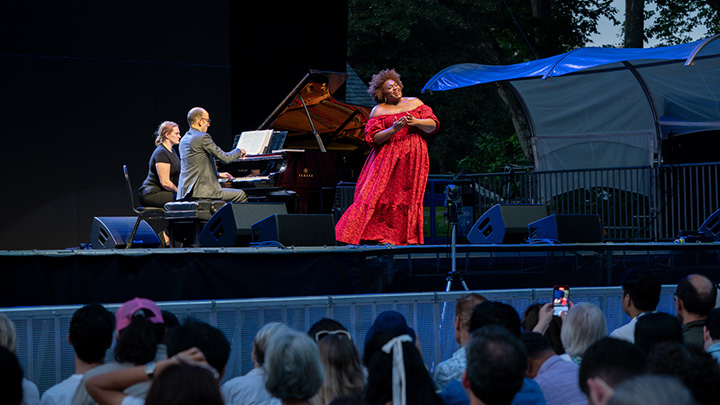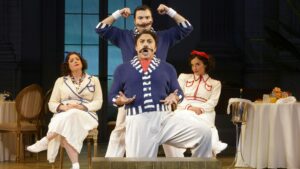You hear the singers in a variety of operatic, song and pop repertory and get a sense of their artistic personalities and versatility. I attended both the opening night program on June 18th in Central Park with the trio of soprano Leah Hawkins, tenor Mario Chang, and bass-baritone Michael Sumuel and the first night of the second group on June 24thwith emerging youngsters soprano Brittany Olivia Logan, mezzo-soprano Hannah Jones, and tenor Matthew Cairns in Jackie Robinson Park in Harlem. Only Sumuel had never been in the Lindemann Program – the rest were either graduates, current members, or joining the program next year.
Both evenings were blessed with temperatures in the 70’s with cool breezes – a blessed respite from the sweltering June heat wave. The Central Park opener on June 18th, accompanied by the protean Dmitri Dover on piano, was a wild ride through an eclectic program which pushed the performers into different styles and vocal categories stretching their capacities – with somewhat uneven but intriguingly stimulating results.
The biggest conundrum was this year’s Beverly Sills Award winner, Leah Hawkins, who is being pushed for major stardom. It’s clearly a major, major voice which I noticed when she sang a luscious, bell-like Strawberry Woman in Porgy and Bess in the Met’s 2020 new production. I found her performance in Verdi’s Requiem a disappointment last Fall, her performance lacked technical control and polish in exposed and high-lying music demanding classical poise and rock-solid attacks. Hawkins has what I would call a “horizontal” rather than “vertical” soprano – it thrives in broad expansive phrases that take advantage of her rich middle register. Tricky high lying music with vaulting intervals into the upper register tax her stamina and technique. It’s a big notes voice, not a little notes voice.
This is also a growing voice very much in a transitional state – the voluminously dark middle and bottom registers and easy volume and tonal expansion indicate that she is growing into a spinto or dramatic soprano. But the technique needs to be developed to handle that heavy repertory. Hawkins’s staged roles include such varied assignments as Musetta and the Priestess in Aida but outside the Met she has sung Tosca, Giorgetta in Tabarro and Ariadne. Other than that, she has sung mostly contemporary works like Malcolm X. The operatic roles Hawkins sampled in this concert included Sieglinde, Louise, Mimi, Zerlina and an aria from William Grant Still’s Costaso plus “Somewhere Over the Rainbow” and a traditional Jamaican folk tune. The varied and demanding program showed a voice that is developing in several directions at once with rich vibrant tone up, down, and sideways. But here or there are bumps and often she is musically unformed.
Sieglinde’s “Du bist der Lenz” from Act I of Wagner’s Die Walküre benefited from the inherent lush sensuality of Hawkins’s soprano and the expansive “horizontal” vocal writing suited her perfectly – some imprecise phrasing here or there betrayed her inexperience with the music. It made me want to hear her as the Strauss Ariadne and also as Elisabeth in Wagner’s Tannhäuser. “Depuis le jour” from Charpentier’s Louise also benefited from her sensuous timbre, but this is a lyric soprano aria with a very vertical vocal line – the melody takes the soprano ever upward into the stratosphere as Louise exults in her newfound love. Hawkins has a big lush upper register but it isn’t as flexible as one wishes – the highest phrases toward the final climax were assisted by vocal scooping. Her part in the “O soave fanciulla” duet from Act I of Puccini’s La Bohème, in partnership with tenor Mario Chang, was another foray into lyric soprano land and a successful one.
Composer William Grant Still wrote his opera Costaso in 1952 but it waited 40 years to be performed. In the second half, Hawkins’ was radiant in the aria “Golden Days” where a disillusioned wife remembers the early passion of her marriage that she hopes to recapture. The golden glow evoked by Still’s rapturous melody was palpably present in her tone. Hawkins had plenty of sass and flirtation as a not-so-innocent Zerlina in “Là ci darem la mano” with the silky Michael Sumuel as her aristocratic Don. Again she was a tigress masquerading as a kitten but the voice is gorgeous. She showed even more sass and humor in the Jamaican folk tune “Nobody’s Business (But my Own)” where she got down without condescension or artifice. For her encore, a gleaming “Somewhere over the Rainbow” from The Wizard of Oz showed off her silken tone, but she also modulated into a higher key for the final reprise of the melody, taking us off to soprano heaven.
Hawkins mentioned that this was her third concert in the parks and she was a gregarious, fun-loving and generous performer. It seems ungracious to carp, but the potential is so great and much of it seems partially realized. Hawkins also needs to find operatic roles and repertory to make her own. She needs to smooth out some technical flaws before she ascends to the topmost rank of operatic artists where her vocal endowments clearly indicate she should be. She is in a dangerous developing state right now with attendant pitfalls. Leah Hawkins needs careful nurturing and handling and lots of coaching.
Guatemalan tenor Mario Chang is another Lindemann graduate with a voice in a transitional state. Initially Chang was heard as a very light lyric tenor but with an unusually dark, muscular timbre for a lyric voice. The sunny tone and easy tops of a Camarena or Flórez were not part of his arsenal. However, his elegant phrasing and modest charm made him a winning Nemorino when he took over the role for one performance from the vulgarly self-indulgent and showy Vittorio Grigolo (whom I do love against my better judgment and wish could be uncanceled and return to the Met). Chang’s turn as Arcadio in Florencia en el Amazonas last Fall showed a voice that had grown in size and force more in keeping with the spinto color of his tenor.

Chang opened the concert with “La donna è mobile” from Rigoletto, but his Duca was a little bumptious and lacking in sunny insouciance. He needed more bel canto and less can belto. His “Venti scudi” duet from L’Elisir d’amore (with the not exactly buffo Dulcamara of Michael Sumuel) was fluent and more his meat. However, launching into Don José’s “La fleur que tu m’avais jetée” from Carmen his mix of dark spinto and lyric qualities found a proper métier. He had both dark passion and lyric elegance in a role that has attracted singers of different vocal weights like Henri Legay, Nicolai Gedda and Jon Vickers. In the second half, Chang sang a sizzling “Granada,” a melting “E lucevan le stelle” from Tosca, and blended pleasingly with Sumuel in the duet “Au fond du temple saint” from Bizet’s Les Pêcheurs de Perles. His encore treated us to a seductive Guatemalan love song in the style of Astor Piazzolla. While the increasing size of his tone is welcome, I do think Chang needs to cultivate greater ease, brightness and shine in the upper register – some of his high notes sounded effortful and covered. It is a gorgeous voice and one that is still developing.
In many ways the most complete artist on that stage was bass-baritone Michael Sumuel, a singer I only remember (positively) in a bit role as the King in the English-language Cinderella/Cendrillon of Massenet. Sumuel is a take-charge interpreter in all his varied assignments, going right into the personality and motivating emotions of whatever character he was portraying in the moment. The words land with meaning and force and his face is constantly reflecting the character’s thoughts and emotions. His mahogany bass-baritone is rich and smooth and evenly balanced from top to bottom.
Leporello’s Catalogue Aria “Madamina” was deft and light-footed with subtle innuendo rather than heavy-handed hamming. Some ham is required for Dottore Dulcamara in Elisir and Sumuel’s buffo patter needs a little more speed and oomph, but his tone is quality from bottom to top. Sumuel’s “Non più andrai” from Le Nozze di Figaro danced nimbly over the words and melody. After intermission, Sumuel rollicked through “I got plenty o’ nuttin” from Porgy and Bess,making one wish he had the Met production and revival and not the spiritless, lumpen Eric Owens. Wolfram’s ode to the evening star “O du mein holder Abendstern” from Wagner’s Tannhäuser revealed sable tone and poetic impulses in the phrasing. He firmly anchored the low end of the Pearl Fishers duet with Chang. His encore was a stirring “Some Enchanted Evening” from South Pacific. Sumuel has the lead Figaro in the second run of Le Nozze di Figaro in the Met’s revival next season – I am going to check him out.

Monday night’s trio were younger and wetter behind the ears but all had gorgeous voices and were winning interpreters in a nicely balanced program accompanied by Deborah Robertson, herself part of the Lindemann Program in their coaching and music staff division. Mezzo-soprano Hannah Jones, with a great stage face and striking outfit opened the show with a vibrant “Cruda sorte!” from Rossini’s L’Italiana in Algeri with round, cushy contralto-like tones and some bel canto sparkle in the second half. The smoky richness of her tone suited Dalila in “Mon coeur s’ouvre à ta voix” (though she needs not to chop up the word “ivresse” into two distinct separate syllables – “eevreh-ssuh”) and she was a striking earthy, wily Carmen in the “Seguidille.” Jones was moving in her encore “Your Daddy’s Son” from Lynn Ahrens and Stephen Flaherty’s Ragtime. Jones will be joining the Lindemann Program next year and I will be looking out for her.

Lyric soprano Brittany Olivia Logan (in her final year at the Lindemann Program) sang the “Jewel Song” from Gounod’s Faust with pretty shallow tone and a barely indicated trill with too much primping. Later in the program, Logan scored mightily with Puccini and Cilèa indicating that Italian opera is her meat. Her “Io son l’umile ancella” from Adriana Lecouvreur got a big ovation from the crowd and her tone gaining in richness, depth ,and sheen. She followed up this positive impression in the duet “O Soave Fanciulla” as a definitely flirtatious Act I Mimì with ardent tenor Matthew Cairns and her encore, “O mio babbino caro.” I found some parts of Micaela’s “Je dis que rien m’épouvante” stretched her tone a bit. Logan also duetted with Jones in the Hoffmann “Barcarolle” quite attractively. She has the role of Liù coming up next May at Lyric Opera of Kansas City and I think Kansans are in for a treat. Wendy Bryn Harmer will be the titular icy princess.
httpvh://youtu.be/kXX8Oyq4Vmw?t=71
Toronto native Matthew Cairns possesses a very promising Lirico-spinto voice with jugendlich heldentenor potential. He is a current member of the Lindemann program. His only role at the Met so far has been the Messenger in Aïda. Cairns has a debut lined up as Froh in Das Rheingold at the Paris Opera and you can hear a little Lohengrin and Walther von Stolzing in the sound. His “Dein ist mein ganzes Herz” from Lehar’s The Land of Smiles had lyric lilt and heroic ring in equal measure. His “Recondita Armonia” from Tosca also had a nice blend of spinto passion and lyrical French finesse and he was an ardent Rodolfo with Logan in the Act I La Bohème love duet. His best contribution was a role he has already performed onstage – Don José in Carmen. Again, the blend of dramatic bite and elegant French lyricism worked in his favor and he shaded the final B-flat from full-toned to mezza-voce with ease. Another growing voice with lots of potential as well as lots already achieved. Cairns could be an impressive Samson in the Saint-Saëns opus in the future. His tone currently is fresh and bright and he is an engaged and positive interpreter onstage – I see a bright future for him.
httpvh://youtu.be/-9DcaXAd1us
In fact, this group of young singers made me very optimistic about the future of opera – all the voices had distinctive timbres and they brought positive interpretations and personality to their work. Also, several of these voices are large and capable of important operatic roles.
Photos: Jennifer Taylor








Comments